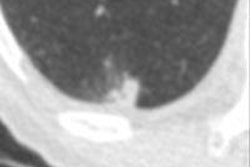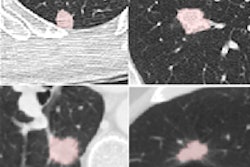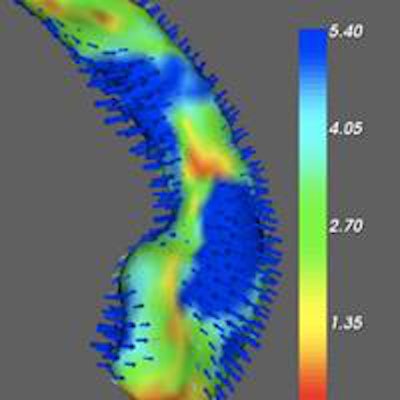
A start-up firm in Madrid is fomenting something of a revolution in how advanced visualization software is developed and implemented. MedimSight is in the business of helping developers and users worldwide find each other on a website and in the cloud.
The company's image-analysis marketplace -- small but very much operational -- works by bringing together all kinds of imaging researchers with a broad array of image-analysis software developers on a single site where users can store and analyze their images, and software developers can upload their best image analysis applications.
Workers laboring to build out the distributed platform in Spain's autumn heat hope to someday host hundreds of software applications to choose from to analyze a particular image dataset, while allowing developers to benefit from a wider audience for their applications, according to MedimSight CEO Javier González Glez.-Zabaleta.
 MedimSight founder and CEO Javier González Glez.-Zabaleta
MedimSight founder and CEO Javier González Glez.-Zabaleta"Developers can distribute and receive more feedback about their products -- and our clients can pay for use of a method as pay-per-service, so developers can put a price on that method," he said in an interview with AuntMinnieEurope.com.
When a client pays, say, 20 euros to analyze a dataset, the developer gets two-thirds of the revenue, MedimSight keeps the remaining one-third, and the user saves the cost of developing software in house and storing the images, which are all stored on MedimSight's cloud server, he said.
González Glez.-Zabaleta founded the company a year ago and launched the website just four months ago, so online offerings to date remain quite modest. Just a handful of image analysis tools have been uploaded and are actually operational. But the firm's plans are ambitious with another dozen or so being finalized and readied for launch in the near future.
That work is no coding cakewalk. The code for each application must be modified and data uploaded to conform to MedimSight's platform requirements, creating a lot of work for the small Madrid-based team of seven developers, he explained.
"We have been talking with developers and moving the methods to our platform, and it's taken some time because they have to make some changes in their code," he said, adding that things are easier for the users, who simply upload their images onto the MedimSight cloud, and then select which methods they want to apply to those images.
"For example, if they are neurologist and they have an MRI of the brain and they want to improve visualization of the hippocampus, they can apply that method made by a third party -- for example the Oxford FSL team," which manages a comprehensive library of analysis tools for fMRI, MRI, and diffusion-tensor brain imaging data, he said. "We are working now with four big hospitals and influential doctors."
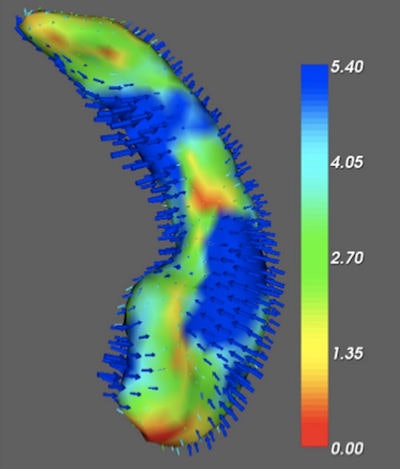 Hippocampal volume analysis. Image courtesy of MedimSight and FMRIB Analysis Group.
Hippocampal volume analysis. Image courtesy of MedimSight and FMRIB Analysis Group.Specifically, MedimSight is in advanced negotiations with several development teams including Laboratorio de Análisis de Imagen Médica y Biometría (LAIMBIO), Centro de Investigación Médica Aplicada (CIMA), and Brain Dynamics in Spain, Functional MRI of the Brain (FMRIB) and King's College in the U.K., as well as FMRIB Analysis Group and Kings Collage in the U.K., DiaCardio in Israel, and Boston Children's Hospital and Harvard Medical School in the U.S, González Glez.-Zabaleta said.
Low-cost cloud
Beyond image-analysis applications, MedimSight provides storage and visualization services as a normal cloud PACS with voice transcription and 100% HTML, without plugins or downloads.
"We have very cheap prices for this service because we think our clients should spend their money on analysis," he said. "MedimSight is not just a platform to make things easy -- it's to enhance and distribute computer-aided diagnosis [CAD] research.
The company's cloud provider is Google, which also provides Google Storage and Google Compute Engine services for the startup.
"We are ready to work in the U.S., Europe, or any other part of the world with the same service quality," he said. "Today, the U.S., Europe, and China are our main goals."
Tools you can use
Segmentation platforms on the site include a whole brain segmentation application that segments cortical and subcortical brain structures using FreeSurfer with normalized data.
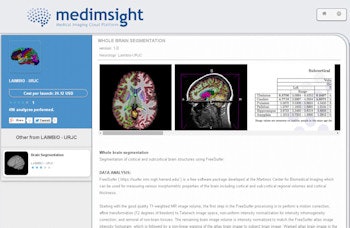
Another brain segmentation application separates 3D images of the brain into different tissue types: gray matter (GM), white matter (WM), and cerebrospinal fluid (CSF).
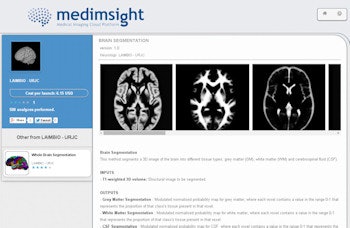
Image quantification applications from CIMA are also in progress and negotiations, he said. Going forward, colorectal cancer, lung, brain, and cardiac CAD applications are expected to draw a lot of interest from users and developers, he said.
Their own research
To find the best image-analysis algorithms, González Glez.-Zabaleta and his team don't just sit around waiting for software developers in universities to come knocking; they actively read journals and other sources in a continuous review of CAD articles and applications and contact the people who develop them, he said. On the site, each application will have its own validation information, ranging from clinical studies to CE or U.S. Food and Drug Administration (FDA) clearance.
"We talk with our clients who used to be doctors or researchers that are interested in some method, and we talk to them and try to help them put their methods on our platform," he said. Part of the job is convincing potential developers that it's better to have their products featured on a widely available site with its own secure cloud system for customers and its own computing power, rather than try to go it alone, providing everything from infrastructure to marketing.
Many developers don't have the computing power they need for wide distribution, or lack the technical expertise to make wide use of their impressive work, he said.
But in exchange for access to developers' talent, MedimSight says it can provide the most advanced CAD methods and biomarker quantification systems available, direct from the developers -- strengthening the work of specialists with a wide range of image-analysis products, and allowing algorithms that previously might have been lost to time after a single application in a study to be monetized for the developers, widely distributed, and continuously improved over time thanks to user feedback.
MedimSight doesn't mass-market its image-analysis services due to the small potential user base, but it does contact imaging researchers it believes could someday be looking for image-analysis help without writing and staging their own application from the ground up, according to González Glez.-Zabaleta.
"We think it's the best option to not only earn money, but even better to get feedback and with this feedback let all the people, not just one hospital or university, use your method in a simple way," he said. "You don't have to use Linux or Windows, you just upload your images and click on the method you want to apply, and then get the results, saving money, saving energy, saving computer time, and saving a lot of money on the analysis."
More information on the company can be found here.





